
NOTE PLEASE THAT: Aconcagua is not a trek only; it is a mountaineering expedition as well. Although it is a non-technical ascent, it is a long and extremely tiring climb at high altitude.
Follows the altitude on each mountain here below!
ACCLIMATIZATION: Pasochoa (4,199m/13,773ft)
ACCLIMATIZATION: Pichincha (4,794m /15,724ft)
ACCLIMATIZATION: Iliniza North (5,125m/16,810ft)
Volcano Cayamne: (5,802m/17,582ft) – We will climbing this summit before going on to our next gold. Aconcagua Mountain is at 6,959m/22,825ft – The roof of the Americas.
EXPEDITION ITINERARY ECUADOR-ARGENTINA ACONCAGUA 22 DAY CLIMBING EXPEDITION TRIP
Pick up at the airport, transfer IN to hotel. Hotel Embassy.
We depart at 8:30 A.M. and travel 30km south of Quito to the Cerro Pasochoa at 4,199m (13,773ft). It is an ancient and highly eroded volcano, which has been inactive since the last ice age.
We drive to the parking lot, and from here we follow the track as it surrounds the eastside of the mountain heading towards the rocky peak. This easy ascent will take us 3-4 hours to reach the summit. We’ll rest for an hour, having lunch during this time. Then we’ll hike 2 hours during down to the parking lot, then drive back to Quito in the afternoon. Hotel Embassy (B./BL)
We take our first acclimatization ascent on the 4,794m (15,724ft) Ruco Pichincha, which is a very good mountain for beginning the process to acclimatize, we take the route and hike up to arrive at the summit, the other one is more interesting, you learn to climb the volcanic rack, we do climb direct ,we use ropes to ensure a safe climb with the harness and pruxicks.
On this way we cross the death pass, where it is impressive to learn how you can make the difficult pass, after this you can go easily to the top. From here you can see Quito City, as well as other very nice panoramas, too. Quito is nestled on the slopes of this beautiful mountain. Our primary goal here is to help each team member to start testing his or her response to higher elevation and to give our bodies a chance to get used to altitude, while enjoying the many photographic opportunities. In the afternoon drive back to Quito, Hotel Embassy. (B./BL)
After breakfast, we make a mid-morning departure from Quito to the Ilinizas parking lot. We’ll leave Quito, going south on the Pan-Americana Highway, where we cross a rich green and fertile valley, commonly referred to as «The Valley of the Volcanoes». After an hour and a half, we’ll arrive at a remote paramo in an area called La Virgin.
From here it is a 3 hours hike up to the refuge with our full back pack on. The refuge is located at 4,600m, (15,092ft). We’ll have dinner and sleep in the refuge. (B/BL/D)
We’ll get up early in the morning at 5:00 A.M. for breakfast and depart for our summit attempt on Iliniza Norte. This peak is normally a fairly straight forward climb that sometimes requires acclimatization days. The trail on the mountain is rocky, almost difficult to find this way. If the weather conditions are bad and cloudy, it’s very easy to lose your bearings. On one part of the route we will use a fixed rope to pass or negotiate «Death Pass.
After this pass we’ll reach the summit. The average time to the summit is 3 hours. Here we stop for pictures and lunch, then descend for an hour and a half to reach the refuge, resting before going down to the parking lot. Our private car (4x4transportation) will take us out for one of our hotel destination in Machachi villages on the way to Cayambe Mountain. Or we can back to Quito. Resting afternoon. Hotel Sierra Madre. (B/BL)
Depart from la Estación at 10:00 A.M., From machachi we drive North direction, we pass same important villages like EL QUINCHE the very catholic town, were is the most important church on this region of the Andes. We have the opportunity to visit the (QUITSATO) means(THE ECUATORIAL LINE IS NOT ONLY AN IMGINARY LINE, IT’S MUCH MORE THAN THIS; IT’S IS A PROFOUND SENCE OF BEING) we stop here for one hour to visit this very important information. After we continue drive and arrive at the Cayambe village where we can have typical lunch form the people of this area. For 1:30minuts drive more we can reach the Cayambe volcano and refuge by 3-4 pm.(4700m / 15,416ft) Located northeast of Quito on the eastern ridge of the Andes, Cayambe is Ecuador’s third highest peak and stands at 5790m (18,991ft.) and his summit is just 3km north of the Equator Line. The glacier of this mountain is large and among the most active of all equatorial ice flows, and its varied glacial terrain here provides an excellent training skills ground and a rewarding to summit climb. Overnight at hut. (B/BL/D)
Alexander Von Humboldt after his visit to Ecuador wrote about this volcano: «This mountain can be considered one of the monuments with which nature has made a big difference on Earth.»
(The world Quitsato is from the Tsafiqui language of the Scachilas people from the Ecuadorian coast. Quitsato means Middle and TO means world – Quitsato therefore means Middle of the world.
Quitsato is the first Ecuadorian integral progect wich is developing extensive work concerning the study ans has put value to the concept of the Equatorila line, the fundamental base of the culture identity of the Ecuadorian.
Quitsato original in the equinctial Andes, specifically on the equinoctial line (the great on the celestial aphere midway qetween the celestial poles) and the archeological culture patrimony.
We attemp not only to learn about the existences and funcionality of these archaeological sites with the application of satellite technilogy. But also to make them know thrugh a continual work of cultural diffusion. Protection and safeguarding of the cultural heritage)
Cayambe Glaciers School day. Wake up at 7 am for breakfast. We continue adjusting to altitude acclimatization. We go on the glacier at 8h30 AM. And engage in the moderate glacier section a good activity. Where well be familiarize ourselves with the various climbing techniques, equipment work for climbing. Our guide get to you on a glacier skills all of techniques necessary for climbing the high peaks like Cayambe, Cotopaxi, Chimborazo and others mountains to.
We’ll be beginning to learn with ice-axe and crampon’s using well handling, hike glacier travel snow, four point climbing using, cross over steps, three O’clock techniques and much more skills to safety procedures you need to now for climbing!! and practice rope-handling traverses with the team over the glacier, all the general procedures for highest peak mountains. After 6 hours training we are back to refuge for delicious lunch and resting afternoon, Of course we Prepare a the teams for a midnight departure for Cayambe day summit. Early dinner and early to bed usually by 6:30 P.M. Refuge. (B/BL/D)
Wake up at midnight. Breakfast and final equipment check. We leave the refuge at 1:00 A.M. and climb with headlamps for the first four hours. We have an easy glacier climb to a saddle and then continue onto steeper and exciting grounds. We’ll traverse around large crevasses and pass some spectacular seracs.
Climb 40 degree slopes with occasional short steeper sections. 200mt below to the summit we will climbing over 60 degree for two peach of rope then the final part we hiking up for 1 more hours to reach the Cayambe summit we reached at about 9-10.A.M. You will have a view of photogenic lines and spectacular mountains. If the weather condition is nice 😉 short rest and return down for 3-4 to the refuge around 2:00 P.M.
Short rest and then we can drive down to Cayambe City and continue drive to papallacta Resort host Spring to enjoying it and rest. (B/LP)
The hydrothermal value of Termas de Papallacta’s Hot Springs is confirmed because of it’s location between two volcanoes, Volcano Cayambe and Volcano Antisana. The temperature of the thermal baths varies between 30°C and 70°C (86°F and 158°F). At the pools the temperature ranges from 36°C to 40°C (97°F to 104°F).
Papallacta´s thermal waters contain sulfates, sodium, calcium, chloride and traces of magnesium, which are odorless, colorless but have a slightly salty taste. Besides improving intestinal function, the baths’ curative properties are also anti-allergenic, anti-inflammatory, diuretic and anti-rheumatic. We have lunch at 3:00 P.M. then come back to the Airport to take the flight down to Mendoza in the evening at 9:45 P.M., arriving in Mendoza the next day at 11:30 A.M. Transfer IN with EAI guide.
NOTE: this fly depending on the availabilities from the company flies.
Today we can make the transfer into Mendoza city. EAI expeditions tour leader will finalize the papers to enter to Aconcagua Provincial Park. Here, we must complete our applications to enter the park. Ecuadorian Alpine Institute meets all permit charges, so all you will need is your passport, a copy of your insurance certificate and a pen. Once these minimal formalities are completed, we may continue our drive! Immediately we take our private mini bus to drive 2 hours to Uspallacta Village, which is on route N 7, to have lunch at a very good restaurant (Don Pato) featuring delicious local cuisine (Beef de Chorizo with red Wine) or other very good local cuisine. Around 5:00 P.M. we leave Uspallacta to drive another 2 hours to Puente del Inca, arriving around 7:00 P.M. We stay at a hotel in Puente del Inca. The altitude here is 2,800m (9,186ft), the same altitude as Quito. We have dinner here and rest for the night. From Mendoza to Puente del Inca it’s a 4 hour drive, 180 Kilometers on route N 7; this route goes to Chile as well.
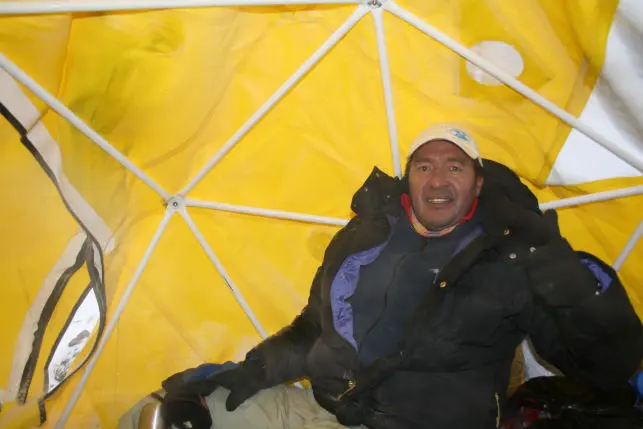
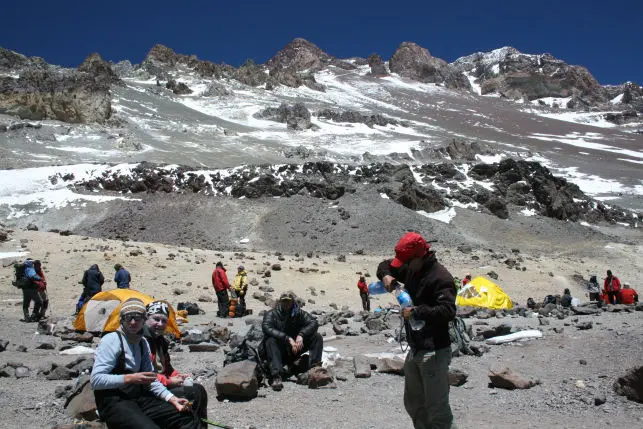
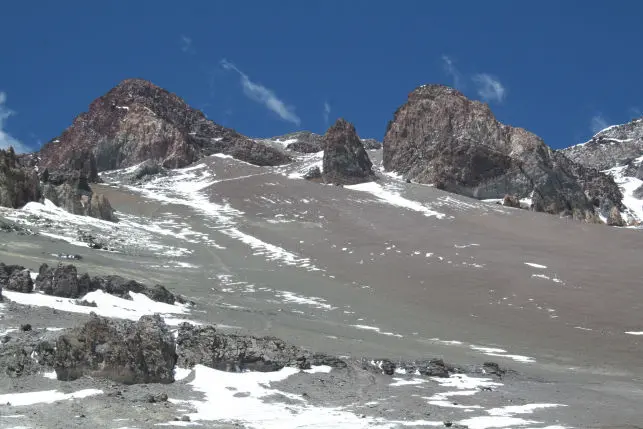

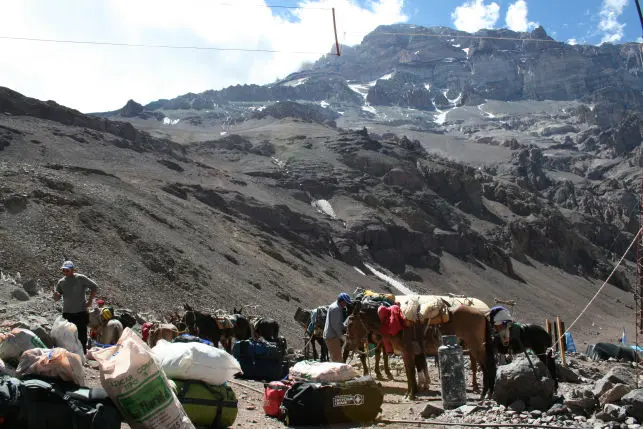
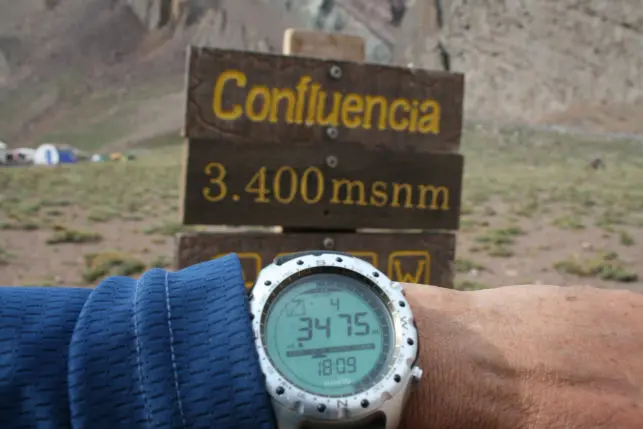
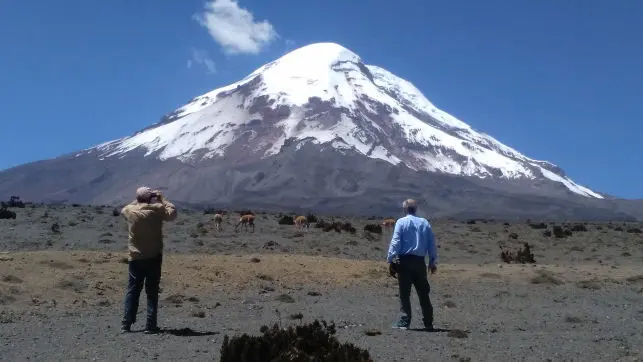
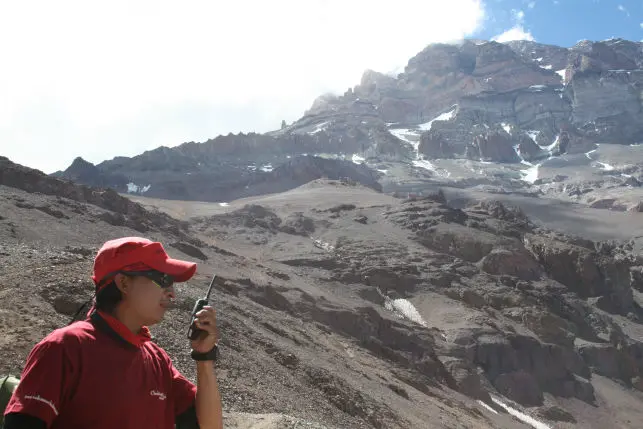
Hosteria Puente del Inca was built in 1925, at the time a luxury place available only for the most important personalities. On the way to Las Cuevas (the border with Chile) you can enjoy this curious geological formation at one of the most famous hot springs resorts of Argentina. Bathing in these waters is recommended for many different conditions, and added to the uniqueness of this natural monument and surrounding landscapes, Puente del Inca is a unique place, Located on the Cordillera de Los Andes, 2800 meters above the sea, Puente del Inca is famous for it’s natural bridge, declared a Natural Monument, and unique geological features.
The bridge has been formed by the action of mineral waters. The river flow is pushed through sediments deposited at the bottom and then hardened by the hot springs. This gives the area it’s colors of oranges, yellows and ochres. The history of the bridge begins with the Inca Trail and their legends. It is assumed that it was known and frequented by this culture to harness the waters healing properties. It’s fame is mainly due to its thermal baths. There are buildings on the side and under the bridge with small pools where the water forms hot springs, which come from natural springs. In the morning you can go to swim, take a small hike, etc.
You can feel free resting half a day, or you have time to check your personal climbing gear. After lunch, around 2:00 P.M., our tour leader meets you to prepare everything for the next big day. All members of the group go up to the Horcones entrance with your permits to CHECK IN, because the next day we can begin to hike at 7:00 A.M. from the Horcones control gate. From Hosteria Puente del Inca to Horcones is 3km. We can hike or drive there, and come back to the hosteria the same way. Immediately, we’ll sort out our bags for the mules, as these will be taken early the next morning and delivered to Plaza de Mulas, our next stopping point at base camp. We end the day with dinner and head to bed. (B)
We get up for breakfast at 6:15 A.M. We catch a private car from Hosteria Puente del Inca to the Horcones Guarda Parques entrance, where we already checked in the day before. This day we begin our approach to Aconcagua. Mules will carry all of our expedition food and equipment, enabling us to enjoy this spectacular day hike with a light day pack. The trail follows the Horcones River to the junction of the Lower and the Upper Horcones River. After crossing the Lower Horcones on a footbridge, we continue up the river valley towards Confluencia, 3,400m (11,155ft), where we’ll pass this intermediate camp. From Horcones to Confluencia we’ll hike about 2 and a half hours.
In Confluencia we have an hour to rest, drink a hot café, then continue our long route. While other climbers spend three nights at Confluencia in order to adequately acclimatize for climbing Aconcagua, EAI groups arrive here with very good acclimatization from Ecuador after climbing Mt. Volcano Cotopaxi at 5,897m (19,347ft). This is a tough day – taking about 11-12 hours to reach the base camp Plaza de Mulas. We start relatively early at 7:00 A.M., armed with no less than 4 liters of water per person, as the valley that stretches ahead is hot and dusty, even though a river runs across the wide plain of the valley floor. After 4 hours walking along a very gentle rise, and avoiding river crossing, if possible, in order to keep our boots dry, the valley splits, and the route swings to the right (north).
Here, we rest for lunch and prepare for the sudden rise in altitude that will accompany the afternoon’s stroll. The path rises steeply to complete the hardest day of the expedition, so far. By the time we land in Plaza de Mulas, we will have climbed nearly 1,481 meters during the day. We settle into our base camp tents at Plaza de Mulas base camp 4,200m (13,779ft), and get to know the local staff, who will support us from this point on. (B./BL./D)
Today is just for resting the full day and recovering our energy at the new altitude on Aconcagua, at Plaza de Mulas base camp at 4,200m (13,779ft). A day off allows everyone to readjust and to get ready for the ongoing climb upwards. EAI will supply you with breakfast, lunch and dinner every day we are in the base camp.
Hot drinks will be provided regularly as well as water. In the afternoon the expedition leader will prepare a list of what to take. At the same time, equipment will be prepared for the local porters to carry, which ensures you will only have to carry your own personal equipment, with all the group’s stores and food being taken by the porters who support the team. We’ll spend the night at base camp Plaza de Mulas. (B./BL./D)
After breakfast, we leave the base camp Plaza de Mulas at 9:30 A.M. We take our food and gear to leave at Nido de Condores Camp and prepare the logistics at Camp 1 for the next day’s expedition on the very high altitude before attempting the summit. Today we carry gear up towards Camp 1, 5,559m (17,100ft).
From our base camp in Plaza de Mulas we follow the trail as it gradually suitcase from steep screen slopes to the rock spires that mark Canada Camp at 5,000m (16,500ft). We pass Canada Camp and head up to Nido de Condores, our next camp 1. This usually takes 5-6 hours.
We set up the tents and you’ll have time to take great photos. If the weather conditions are good, you can see the sun set like in the ocean. We have dinner at high altitude and stay overnight at Nido de Condores to measure our acclimatization before going to our next high camp 2 Colera at 5,890m (19,437ft) (B./BL./D)
Hike down to base camp Plaza de Mulas. Today is just to measure how our body is acclimitizing after we spent the night at high altitude. Around 11:00 A.M. we can move down to Plaza de Mulas for a resting afternoon and to recover our energy. We’ll stay overnight at base camp Plaza de Mulas. (B./BL./D)
After breakfast we can move out at 9:00 A.M. to arrive at our Camp 2 COLERA, which is a bit higher than Berlin camp. Colera camp is located at 5,970m (19,569ft), 40 meters higher than Berlin Camp. Today we can make our first foray onto the mountain; from Plaza de Mulas to Colera we climb 1,600m (5,249ft). In the first 3 hours of climbing we pass Canada Camp, continue our climbing, we pass slope changes and from here we take another hour to arrive at Nido de Condores. We rest a short time her to eat and drink then continue our climb for another 3 hours. We follow the head trail up through the same route to Berlin camp towards many switchbacks, here you hike more slowly, you may feel low oxygen as well.
From Berlin Camp, we cross just the last traversed part. After climbing a nice rimaya rack we get to the Colera Camp, where our tents are ready, for spending the afternoon resting. This is a really useful day, and past experience has shown that by sleeping on the mountain at high altitude, our acclimatization will be given a huge boost that will enable us to tackle the mountain with more energy and less difficulty.
We have dinner and spend the night at Camp 2 Colera at 5,970m (19,569ft). The EAI Leader checks the weather every day with the park authority by radio. If the weather conditions are confirmed by Aconcagua park, the next day we can move up to make the Aconcagua Summit. If so, we can prepare all the personal gear in the afternoon for the next morning’s climb. (B./BL./D)
We wake up at 4:00 A.M. to check the weather for the day. If the EAI leader and guides agree to go, then everyone needs to get ready for the big day. After breakfast, we should start no later than 5:00 A.M. From Colera camp, we begin climbing up the regular switchbacks, after 45 minutes we can meet the way coming from the Berlin camp. Here we may join many other climbers. Around 6:15 A.M. the sunrise brings a very magnificent view of the Andes. Continuing up at a slow hike, after many other switchbacks we come to another hut (Independencia camp) at 6,377m (20,921).
From here, the route crosses the side of the mountain over screens to break out at the start of the traverse that leads to the foot of a large gully, leading down from the Summit Ridge. Sometimes from Independencia we need to put on our crampons, the entire route is packed with snow. After crossing the side, immediately we hike on the traverse and come to a rock that looks like a gendarme. This rock is the sentinel that watches the traverse and the beginning of the canaleta as well. After crossing the sentinel we climb for long time up.
This is the Canaleta, which is the most strenuous climbing. Eventually it leads to the Summit Ridge and amazing views straight down the south face of Aconcagua. A 35-minute traverse leads across rocky ground and a well-defined path to a short scramble immediately below the top. This leads, without difficulty, to the final steps that lead to the small summit plateau. Here, a cross marks the highest point in the western and southern hemispheres.
Between Nido de Condores to Aconcagua Summit, we climb 1,399m. We take around 8-9 hours climbing up and 4-5 hours climbing down. After we reaching the summit take us a big hug to celebrating the ascent and taking many photographs for the souvenirs, after same rest we descent for the same using the normal route passing the Independencia Camp again to arrive at Colera, where our tents are. Here we have dinner and spend the last night in the high altitude. (B/BL/D)
This day is scheduled for resting only and preparing for our next long summit day push. We spend the day at Colera Camp 2. For EAI groups this is a Summit Bid Day. We have two days to reach the summit. This gives us spare time in case of bad weather, but the summit will be attempted on the first day if possible. With an early start, the summit is attainable in about 8 hours. (B./BL./D)
Two summit days have been scheduled into the itinerary in case of bad weather in any part of the climb. In addition, day 18-19 can also be used as an alternate summit day if climbers require.
This day, we’ll wake up tired but elated. Unlike the previous day, we can afford to let the sunlight bathe and warm our tents before we get up for breakfast. However, once up, it will be a race to get ready and to make a rapid descent down to base camp, where the staff will be waiting to share the excitement of our ascent.
We should all have returned to base camp by mid-afternoon at the latest, which will give us plenty of time for a shower, relaxing and preparing our bags for the walkout. Our final lunch and dinner will be special and no doubt accompanied by beer and wine to have a nice celebration. We spend the night at Plaza de Mulas. (B./BL./D)
After the summit day we have a full day to rest at Plaza de Mulas, recovering our full energy for the next day hiking back down. (B./BL./D)
Today is a long day’s trek all the way down the Horcones Valley to the National Park entrance. We will need to start early today (no later than 9:00 A.M., if possible) in order to make the journey all the way back to Mendoza. The walk will take about 8 hours, with little time to linger over lunch. After arriving back at the gate, at about 4:00 P.M., we then have a 4 hour drive back to town, where we would expect to be back in the hotel in time for a quick turnaround and shower before having dinner at a restaurant at about 9:00 P.M., along with our local guides to celebrate our expedition.
(Which is when the locals go out to eat anyway.) At RESTAURANTE FRANCIS, you’ll enjoy very good Argentinean cuisine. You’ll stay at either hotel Aconcagua (4 stars) or Plaza Hotel (5 stars). (B./BL)
Today, we fly from Mendoza to Buenos Aires to an hotel right at the center of the city. This gives very quick access to the main shopping areas. Buenos Aires in Argentina and Santiago de Chile in Chile are the largest cities in South America and the largest Spanish-speaking cities in the world.
According to peoples’ wishes, the leader can arrange a city sightseeing tour or a guided visit to a local ecological reserve. After a full day, in the early evening, we leave to the airport to catch our flights back home. (B.) (If your flight is not too early.)
Hotels accommodation in Ecuador & Argentina (7 Night at double bead with American Breakfast)(as described on the Itinerary)
Bilingual certified Mountain guide.
All private transportation.
All meals while on the climbing trip.
Porter for the group gear.
All tents, cooking gear for the climbs.
Rope and techniques climbing gear.
Mules for carry the gear at high camp, and down.
Climbing permits In Ecuador.
Aconcagua Park fees.
Additional hotels, meals and transportation should the climb end early.
Unscheduled airport shuttles.
Meals, hotels and transportation outside the regular itinerary.
Personal gear.
Single-room supplement for hotels.
Medical/Evacuation trip insurance.
Charges incurred as a result of delays and itinerary changes beyond the control of Ecuadorian Alpine Institute.
We recommend travel insurance to cover any unforeseen costs.
Tips and gratuities
Alcohol and/or bottled drinks.
Personal porters support. (for $.1000 Dollars.)
Made with
Landing Page Software